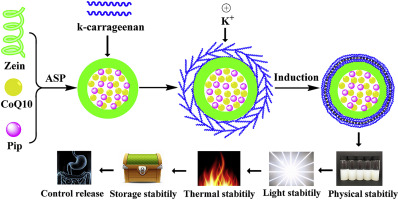当前位置:
X-MOL 学术
›
Food Hydrocoll.
›
论文详情
Our official English website, www.x-mol.net, welcomes your
feedback! (Note: you will need to create a separate account there.)
Core-shell nanoparticles for co-encapsulation of coenzyme Q10 and piperine: Surface engineering of hydrogel shell around protein core
Food Hydrocolloids ( IF 11.0 ) Pub Date : 2020-06-01 , DOI: 10.1016/j.foodhyd.2020.105651 Shuai Chen , Yanhui Zhang , Jing Qing , Yahong Han , David Julian McClements , Yanxiang Gao
Food Hydrocolloids ( IF 11.0 ) Pub Date : 2020-06-01 , DOI: 10.1016/j.foodhyd.2020.105651 Shuai Chen , Yanhui Zhang , Jing Qing , Yahong Han , David Julian McClements , Yanxiang Gao

|
Abstract In the present study, the fabrication and characterization of novel core-shell-type surface-engineered nanoparticles were reported for co-encapsulation of coenzyme Q10 and piperine, which were natural nutraceuticals with synergistic biological activities. Initially, nutraceutical-loaded zein nanoparticles were formed by antisolvent precipitation method. Then, κ-carrageenan was adsorbed to the surface of zein nanoparticles using electrostatic deposition. Finally, the κ-carrageenan layer was induced into a hydrogel shell by using K+ as a cross-linking agent. At low K+ levels (0–4 mmol/L), the relatively small spherical anionic nanoparticles were formed and were stable. However, at high K+ levels (4–10 mmol/L), the nanoparticles formed were relatively large and tended to aggregate. A photodegradation result showed that the half-lives of coenzyme Q10 and piperine were increased by 3.0- and 1.8-fold, respectively, when encapsulated in the biopolymer nanoparticles compared to the free forms. Moreover, their retention rates were increased by 151% and 200% during thermal treatment, and 111% and 131% during a four-week storage, respectively. Besides, the release of the nutraceuticals from the biopolymer nanoparticles in a simulated gastrointestinal tract could be retarded by increasing the degree of interfacial cross-linking. In summary, the core-shell nanoparticles developed here are an effective approach for the co-delivery of synergistic nutraceuticals.
中文翻译:

用于辅酶 Q10 和胡椒碱共包封的核壳纳米粒子:蛋白质核周围水凝胶壳的表面工程
摘要 在本研究中,报道了新型核壳型表面工程纳米粒子的制备和表征,用于共包封辅酶 Q10 和胡椒碱,它们是具有协同生物活性的天然保健品。最初,通过抗溶剂沉淀法形成负载营养食品的玉米醇溶蛋白纳米颗粒。然后,使用静电沉积将κ-角叉菜胶吸附到玉米醇溶蛋白纳米颗粒的表面。最后,通过使用 K+ 作为交联剂将 κ-角叉菜胶层诱导成水凝胶壳。在低 K+ 水平 (0–4 mmol/L) 下,形成相对较小的球形阴离子纳米粒子并稳定。然而,在高 K+ 水平 (4-10 mmol/L) 下,形成的纳米颗粒相对较大且倾向于聚集。光降解结果表明,与游离形式相比,当封装在生物聚合物纳米颗粒中时,辅酶 Q10 和胡椒碱的半衰期分别增加了 3.0 倍和 1.8 倍。此外,它们的保留率在热处理期间分别增加了 151% 和 200%,在 4 周的储存期间分别增加了 111% 和 131%。此外,可以通过增加界面交联度来延缓模拟胃肠道中生物聚合物纳米颗粒中营养药物的释放。总之,这里开发的核-壳纳米颗粒是协同提供协同保健品的有效方法。它们的保留率在热处理期间分别增加了 151% 和 200%,在 4 周的储存期间分别增加了 111% 和 131%。此外,可以通过增加界面交联度来延缓模拟胃肠道中生物聚合物纳米颗粒中营养药物的释放。总之,这里开发的核-壳纳米颗粒是协同提供协同保健品的有效方法。它们的保留率在热处理期间分别增加了 151% 和 200%,在 4 周的储存期间分别增加了 111% 和 131%。此外,可以通过增加界面交联度来延缓模拟胃肠道中生物聚合物纳米颗粒中营养药物的释放。总之,这里开发的核-壳纳米颗粒是协同提供协同保健品的有效方法。
更新日期:2020-06-01
中文翻译:

用于辅酶 Q10 和胡椒碱共包封的核壳纳米粒子:蛋白质核周围水凝胶壳的表面工程
摘要 在本研究中,报道了新型核壳型表面工程纳米粒子的制备和表征,用于共包封辅酶 Q10 和胡椒碱,它们是具有协同生物活性的天然保健品。最初,通过抗溶剂沉淀法形成负载营养食品的玉米醇溶蛋白纳米颗粒。然后,使用静电沉积将κ-角叉菜胶吸附到玉米醇溶蛋白纳米颗粒的表面。最后,通过使用 K+ 作为交联剂将 κ-角叉菜胶层诱导成水凝胶壳。在低 K+ 水平 (0–4 mmol/L) 下,形成相对较小的球形阴离子纳米粒子并稳定。然而,在高 K+ 水平 (4-10 mmol/L) 下,形成的纳米颗粒相对较大且倾向于聚集。光降解结果表明,与游离形式相比,当封装在生物聚合物纳米颗粒中时,辅酶 Q10 和胡椒碱的半衰期分别增加了 3.0 倍和 1.8 倍。此外,它们的保留率在热处理期间分别增加了 151% 和 200%,在 4 周的储存期间分别增加了 111% 和 131%。此外,可以通过增加界面交联度来延缓模拟胃肠道中生物聚合物纳米颗粒中营养药物的释放。总之,这里开发的核-壳纳米颗粒是协同提供协同保健品的有效方法。它们的保留率在热处理期间分别增加了 151% 和 200%,在 4 周的储存期间分别增加了 111% 和 131%。此外,可以通过增加界面交联度来延缓模拟胃肠道中生物聚合物纳米颗粒中营养药物的释放。总之,这里开发的核-壳纳米颗粒是协同提供协同保健品的有效方法。它们的保留率在热处理期间分别增加了 151% 和 200%,在 4 周的储存期间分别增加了 111% 和 131%。此外,可以通过增加界面交联度来延缓模拟胃肠道中生物聚合物纳米颗粒中营养药物的释放。总之,这里开发的核-壳纳米颗粒是协同提供协同保健品的有效方法。











































 京公网安备 11010802027423号
京公网安备 11010802027423号